Blogs
Practical Insights & Latest Happenings
Don’t miss out on the latest trends and info on SEO, search engines, social media, and more.
November 28, 2023
mothasim
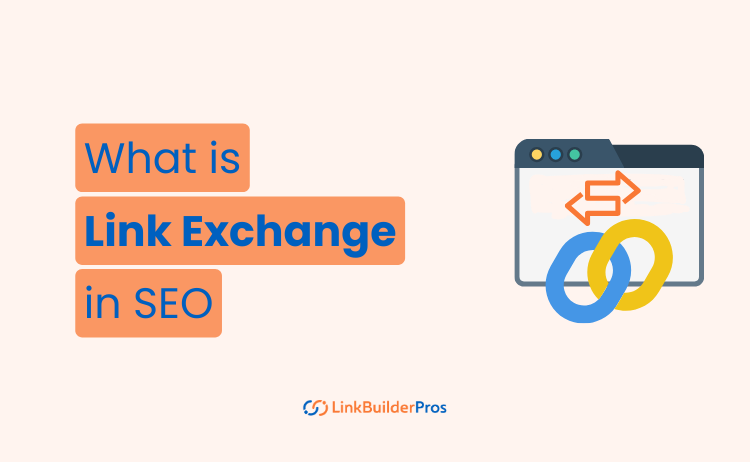
Although Google is not particularly in favor of link exchange in SEO, you can still leverage its benefits without being penalized or devalued. After all, link exchange is still a heavily practiced link building tactic that helps level up SEO.
First you need to know how to do it strategically and safely. Here we will delve into the intricacies of link exchange, exploring its benefits, best practices, and how to leverage this strategy effectively.
You know what a backlink is, right?
When one site links to another site, it transfers a portion of its authority to the other site. It is like a referral — a way for one site to recommend another. Google takes this positively and uses it to measure the authority and relevance of a website.
There are many ways to gain backlinks; some are natural and some are spammy. People try all types of link building strategies to strengthen their backlink profiles and boost their SEO.
Link exchange is a common link building approach where two or more websites mutually agree to share links with each other. The idea is to mutually benefit from increased visibility and traffic. When a website links to another, it usually drives more visitors to that site that helps with SEO.
Link exchange has been popular ever since the early 2000’s because there hasn’t been an easier way to share domain authority and traffic between two websites.
But times have changed and search engines now prioritize natural link building practices, such as building relationships with other websites in your niche, participating in community discussions, and engaging in social media.
Google’s guidelines discourage excessive link exchanges and emphasize the importance of natural, high-quality links. Excessive or manipulative link exchanges are considered as part of “link schemes,” which often leads to penalties.
So, the trend of link exchange has gone a little stale now with Google’s strict guidelines and policies in place.
However, if done right, link exchange can still help you gain some referral traffic, new leads, and an overall improved SEO. In fact, many site owners still exchange links in a safe and controlled environment and help one another out gain more authority.
Here is something you need to know – webmasters can also exchange links just to cross-promote their brands and products. So, link exchange is both an SEO and a marketing tactic at the same time.
Let’s look at the most common link exchange types. Some of them are safer than others.
In fact, this is another name for link exchange where two or more sites link out to one another to boost their individual authority.
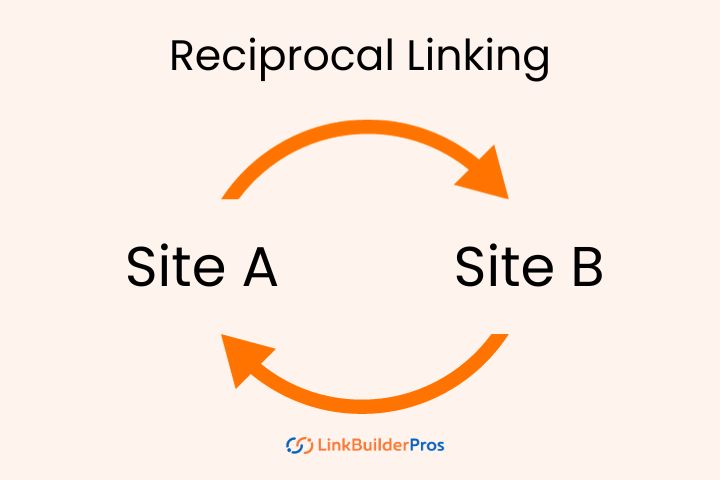
If you’re not trying to gain links in bulk, reciprocal linking seems a natural choice since it may take place between two or more sites out of necessity.
Although Google and other search engines see link exchange as a shady approach, two sites linking each other without any prior agreement may happen sometimes coincidently or sometimes out of necessity.
An Ahrefs study revealed that more than 40% of around 112,000 top-ranked sites exchanged reciprocal links. That means about 4 out of every 10 good websites are involved in the reciprocal link building process. Now you probably understand how reciprocal link building is a common phenomenon in modern SEO.
You can see the breakdown and the conclusion of the study here:
That’s why, reciprocal linking is a safe and trusted link-building approach if you can make it look natural. The key is not to overdo it and focus on creating valuable content worth linking to without forcing anything.
Also known as triangular link exchange in SEO, this idea came up as an alternative to reciprocal or direct link swaps to counter Google spam algorithms.
Google is supposed to detect link exchanges between two sites and penalize both if done in excess. But what if you don’t link out directly?
In three-way exchanges, two high-authority sites use an intermediary site to trade backlinks. So, if Website A and Website C want to exchange, they’ll use a new Website B to pass the links through.

This way, you can trick Google into seeing how naturally the links are flowing from one site to the other. Search engines aren’t yet equipped to figure out where the exchange begins and stops or who the primary participants are in this type of exchange.
As a result, it’s a safe way to make Google think you are exchanging links legitimately.
Some spammers take it up a notch and build link wheels!
A link wheel is a group of websites built solely to provide backlinks to a target site. Let’s say, Website X needs backlinks for authority. You can build a network of websites where one will link to the next and form a chain of websites until they reach Website X and complete the circular wheel.

The problem is that those new sites in the wheel are usually all low quality and so not much link juice passes in the process anyway.
On top of that, Google spam algorithms can detect low quality backlinks too. If unlucky, Google may penalize all the sites involved in the link wheel, including your target site as part of their spam policy.
This is hands down the safest way to exchange links.
Guest posting is a widely practiced SEO technique to help improve brand awareness, enrich backlink profiles and gain referral traffic. Google crawls and indexes your guest posts, which in turn allows the links included to get indexed as well.
The source site lets you secure one or two links back to your website but allows more if you want to link to other high-authority sites. This is what websites take advantage of.
Let’s say Website A and Website B are in a link exchange agreement. If Site A contributes a guest post to a reputable site, it can link back to its own site as well as to Site B. In exchange, when Site B engages in a guest blog for another high-authority site, it can link to Site A.
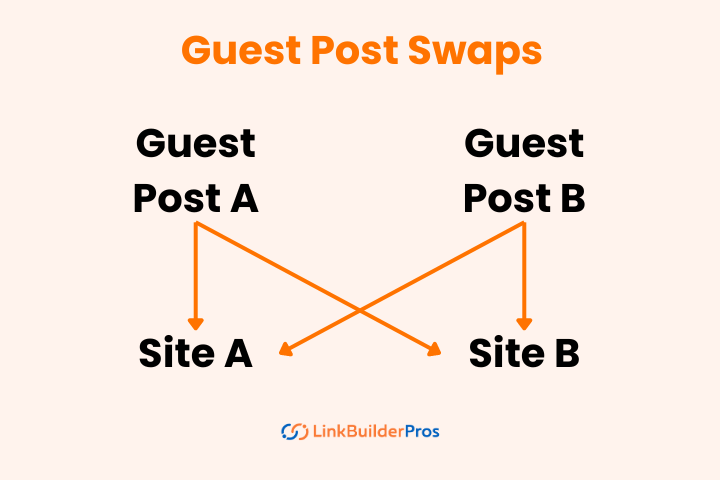
This is applicable for websites that run guest posting campaigns regularly.
The Private Influence Network (PIN) is another link building approach where a few websites partner up to promote each other by providing backlinks.
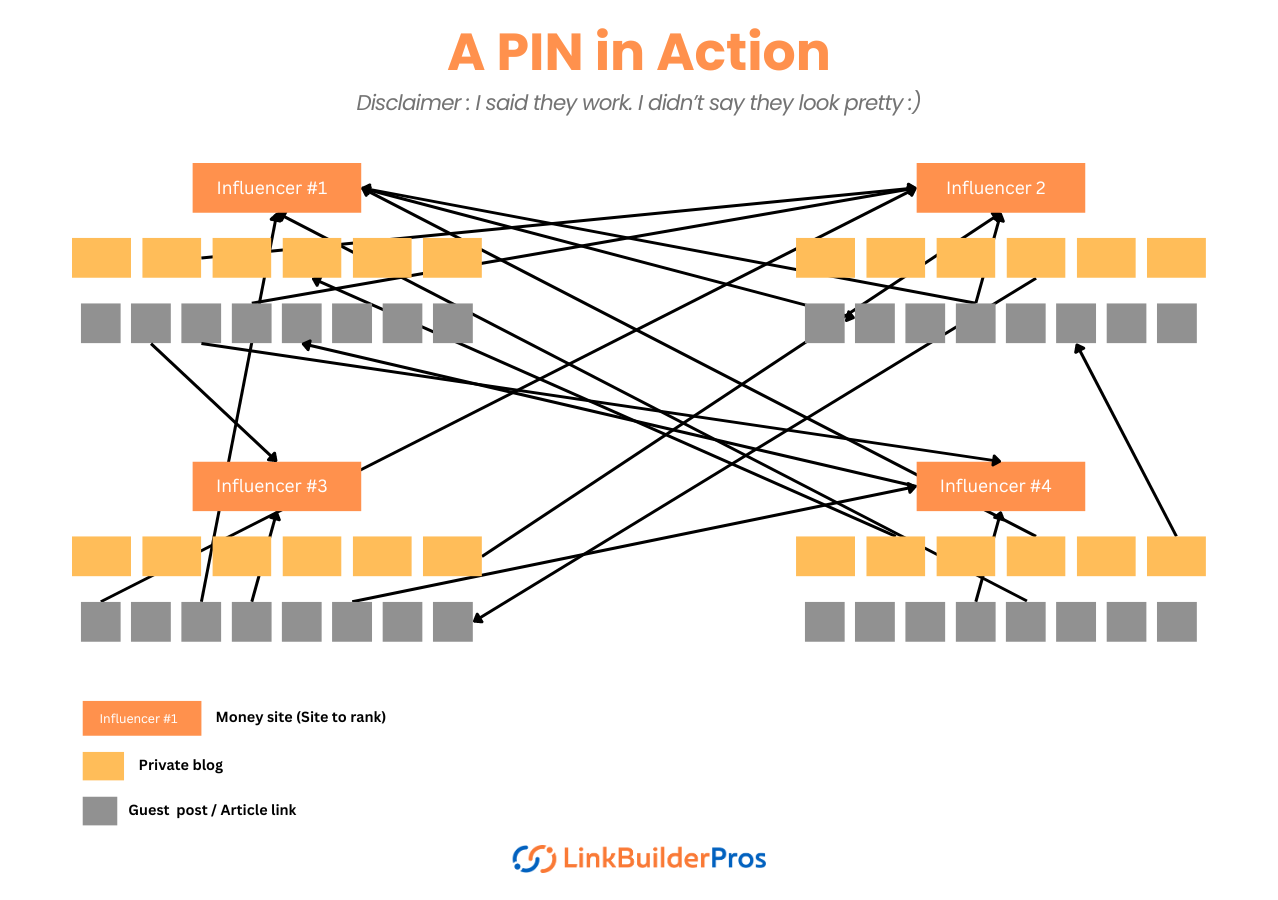
Usually, websites belonging to the same or related niches build a PIN from ground up for their own SEO growth. They’re always interconnected and provide links to each other on different pages. As a result, a lot of traffic circulates among the PIN members and eventually elevates them in the SERPs.
It usually works although Google considers it manipulative and spammy. In fact, if Google ever identifies what’s really going on, the entire network can be flagged as spam.
There is not much of “exchange” involved here. When a website links to you only because of the content you put up or the service you provided without asking for a link to them in return, it’s called one-sided or unilateral link exchange in SEO.
As far as natural link building goes, this is the most authentic and beneficial exchange you can think of!
As said before, Google already considers excessive link exchange as spam.
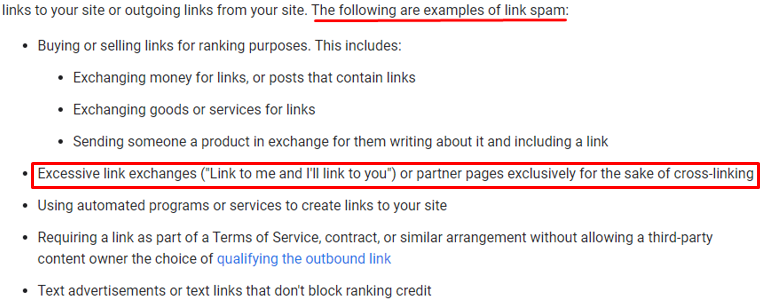
But look closely. The guideline mentions “excessive” before and “exclusively” [for cross-linking] after link exchanges. So, if you’re exchanging links once in a blue moon without making it irrelevant or too obvious, there should be no problem.
This is a ray of hope for those who are already involved in link exchanges. All you have to do is revise your strategies and play it safe!
The best way to go about it is to gain inbound links through reciprocal linking.
Even if you try paid link building, you have to do it carefully. We’ll come to that later.
But always remember that if you breach Google’s guidelines anyway, you have to pay for it since Google penalizes sites for link spams and excessive link exchanges by devaluing them. This results in their drop in search engine ranks.
As you can see, depending on the path you take, link exchange in SEO can be a safe or a risky adventure.
Any black-hat link exchange strategy could end up being penalized while white-hat methods like natural link building are time-consuming. Still, people always find a gray area where they continue exchanging links for a robust backlink profile.
The reason is obvious. If done in a safe environment without offending search engines like Google, link exchange is bound to help level up your SEO.
The only trick is to convince the search engines that there’s nothing fishy going on.
Let’s look at some of the safest methods:
You should always try organic outreach. Improve your site authority by other means such as on-page and technical SEO and putting up quality content.
Focus on personalizing your outreach efforts and building relationships with websites in your niche to get more natural backlinks in the future. Your link building campaign will get much safer that way.
Do the outreach first and convince your prospects that you’ve got a mutually beneficial offer.
Discuss the terms and decide on how you’d like to exchange the links. You wouldn’t want to risk going the old-fashioned way and get penalized for manipulative practices.
Propose an indirect link exchange instead.

You’ll actually be exchanging links here but in a more strategic way.
When you link to a particular content of your partner site in this exchange, make sure it’s a quality backlink and goes well with your own content.
Also, check to see that the backlink you’re getting doesn’t come from the same page of the partner site you just linked. If you keep exchanging links between the same two blogs over and over again, Google won’t like it and find it unnatural.
So, be smart about your link exchanges. The partner website has to play a big role here as well.
We have already talked about triangular link exchange. It’s about avoiding the reciprocal exchange between two sites by involving another site in between.
Find a third-party website you can rely on. This is crucial. If the site you choose as the intermediary turns out to be spam or belongs to a link farm or a link wheel or a PBN, there’s no point in continuing with the idea. Your links will be devalued anyway at the end of the day.
If you’re not familiar with guest posting, this one won’t work for you. You should have some experience with guest posting campaigns so you can find relevant sites and ask for a swap.
The same goes for the other site. Make sure they’re good at guest posting on reputable sites too.
Come to an agreement that you’ll link back to each other’s sites from your respective target sites. Be clear on how many backlinks you each have to provide.
Topical relevance is the key here. Make sure that your anchor text and the link itself make sense. If you include your links without any consideration of the audience you’re writing for, they’ll be flagged as spam and damaging to all the involved sites.
No matter which method you choose, you need to go safe to avoid any type of nullification or penalty from search engines.
A lot depends on the site you’re collaborating with. So, choose your partner just as carefully.
For a successful swap, you should be aware of a couple of things here-
You should be mindful about what you’re trying to do. Link exchange spells danger for you if misused. You can still find the loopholes and make it swing for you in the right direction.
Just take note of how you should engage in link exchange programs-
The simple solution is outreach. However, manual outreach is not always possible. You can research your niche and list some eligible parties but whether they’re interested in your offer or not remains to be seen.
A smarter approach would be joining a social network where all the members are looking for the same opportunity as you. You can easily find some like-minded individuals there and start negotiating.
The best platforms for finding sites for link swapping:
Your job is just to talk it out. Join the online communities and find your prospects. Reach out easily through the chat option and place your offers. Negotiate strategically and you’ll have a partner in no time. Make sure to mutually decide on the safest practices to do your link exchange.
Link exchange is a fantastic link-building strategy in moderation. Our suggestion therefore will be one of balance and common sense.
The most ethical way to approach this issue is to go for reciprocal link exchange. You have to make it happen naturally by building a reputable standing in your niche with quality content and white hat SEO practices.
But we also acknowledge how exchanging links has become an almost inevitable part of SEO in this age of networking and e-commerce. In that case, we’d like you to follow the safest practices possible to make your link exchange campaign a success.
Go back to Google where it says, “excessive link exchanges” and use it to your advantage. Reach out to your friends and do what you do best but not too much.
Q. Is 3-way link exchange better than reciprocal links?
Ans. If the reciprocal linking happens naturally, that’s the way to go. However, Google detects two-way link exchanges to be spam if done in excess. In that case, 3-way link exchange is better simply because the two sites aren’t directly connected and that makes it look like a natural exchange.
Q. How many link exchanges should I aim for?
Ans. Quality trumps quantity. Focus on building links of value and quality instead of a mere number.
Q. What should be included in link exchange requests?
Ans. You should let them know why you’re looking to exchange links, how links might help readers of the other sites and offer high-value positions on your site for their links in the request emails.
Q. Where will my link be placed?
Ans. If you have a choice, make sure the linking page has good authority, fine content and a catchy design. The link should be in a contextual position of the content; not in less prestigious spots like footers or side-bars.
Q. How many outbound links should the linking page have?
Ans. Link juice is divided among all the outbound links in a page. So, you should get your link in a page with a minimum number of outbound links available.
Q. How often should I review my link exchange partners?
Ans. Review how your links are performing in regular intervals. If the linked site is getting flagged, remove your links from them.
Q. Are there alternatives to paid link exchange?
Ans. Yes, the best alternative is to get one-way links for your site. It’s natural, ethical and safe from every angle. Just produce informative and quality content, and maintain your domain reputation so high-authority websites link out to you.